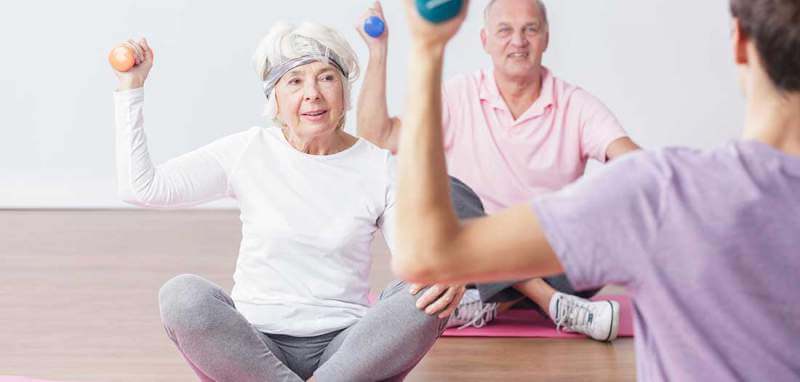I love to debunk that what elderly need to combat their chronic joints and bones pain is rest. I don’t deny the value of rest; sure they need rest but is it all that they need? No, they require healthy foods full of essential nutrient and side-by-side they require a healthy activity that keeps their body in motion for at least a part of a day. If we don’t move our body, it withers in the form of diseases like osteoporosis. I’m sure you must be concerned about your beloved elderly parent, and if you are an individual in your 60s and above, you better start planning a workout for yourself because they help combat diseases like dementia as well. There are gazillion advantages of regular workout for people of all ages. Kids are mostly active on their own and play around a lot. Adults practice working out, sprinting, jogging and various other sports to maintain their bodies; therefore elderly do not have to stick to bed! But at the same time, there are a lot of workouts that the elderly cannot perform. I’ll give you a list of old-bones-friendly exercises that you can perform to keep your body fit and in great shape.

- Circuit Training
Circuit training is another name for high-intensity interval training. HIIT has been on the scene for a while now, and it is considered one of the most effective weight loss remedy. The point is, any movement is better than just sitting around and wasting time. HIIT takes lesser than any other workout that might be on your list. It involves working out with your full potential for shorter periods of time; much like in energy bursts and then taking minor breaks in between. This workout tends to increase your heart rate, which ultimately strengthens your cardiovascular muscles. When we exercise hard, the blood is pumped with more pressure than usual, and it enhances the elasticity of our arterial walls. - Lane Swimming
Swimming is a relatively safer exercise for elderly people. You just have to make sure to nourish your skin properly and moisturize it so it doesn’t crack up because staying in the water for longer periods of time can make your body lose its natural salts. But do not resort to leisure swimming, because it is only useful for people who are very unfit. On the other hand, lane swimming is a better investment of your time and effort. There is one swim technique which if used can bring you excellent result; it’s called fist freestyle. You can swim the lane with any technique with your fist closed. This is because this style requires your bodies to push harder against water since your hands aren’t open anymore and it requires more effort to paddle. - Strength Training
This is the ultimate way of training your body into a weight loss program; stop your bones from slowly withering and building muscle. It is also beneficial for people who have severe heart diseases. Primarily, strength training helps burn the fat. But you don’t need to join a gym or rush to market to get weights; you can very well do the strength training merely by using your own body’s weight. To increase the difficulty level of this kind of training, you just have to increase the tempo slowly and steadily. For example, you can begin by planking for ten seconds and then gradually raise the plank duration to thirty seconds by an increment of five seconds every two days. Side planks are very beneficial for seniors. - Run, Jog, Sprint
Try one..or all three of them. The combination of these three, however, works for almost everyone and it is almost like a HIIT. When one switch between jogging, sprinting and running they end up burning more calories in lesser time. It means that you exert more effort in lesser time, so HIIT is also very beneficial for elderly females who have their cortisol levels imbalanced after menopause. These women find the HIIT highly useful in controlling the overflow of cortisol that can be caused by prolonged hours of cardio. Once again, exercises, like running and jogging, are only useful if you take minimal breaks in between, sitting and resting for long periods of time will render the exercise ineffective. Another approach to running, however, is walking longer distances and more extended periods of time. - Yoga
Did you know that yoga is one exercise that has absolutely no detriment to it? Yoga is useful for all your problems; physical, mental and emotional. It increases the flexibility of your body and amplifies the muscle stability greatly. Looking overtly, doing yoga at a later age seems like a tough task, but there are many poses of yoga like the Tree Trunk pose which is very easy and doable. Yoga might not appear to aid your heart, but it is very beneficial for your vital organs. Once you’re done practicing the basics of it, you can try and start practicing Ashtanga and Bikram yoga. - Cycling
This one is a somewhat risky endeavor, but cycling is excellent for one’s health. Cycling regularly can substantially reduce the chances of you catching a coronary heart disease; this is excerpted from research. It was also revealed that cycling every other day for about 32 kilometers reduces heart disease risk by fifty percent. Cycling is an activity appreciated by people of all ages. My mother used to cycle every single day in her 60s, and she never had a heart disease.
No matter what workout you choose, you ought to stick to it for a considerable period of five days a week. Working out on a regular basis keeps it useful, and you will get used to it in no time. Working out is a lifestyle, not a one-day choice. Staying active will keep you healthier so incorporate it into your daily routine.
 Author Bio:
Author Bio:
This article was written by Chris Palmer who regularly shares advice on elderly care. In particular dementia and supporting your elderly parent. You can find more by Chris on: https://www.agespace.org/.
